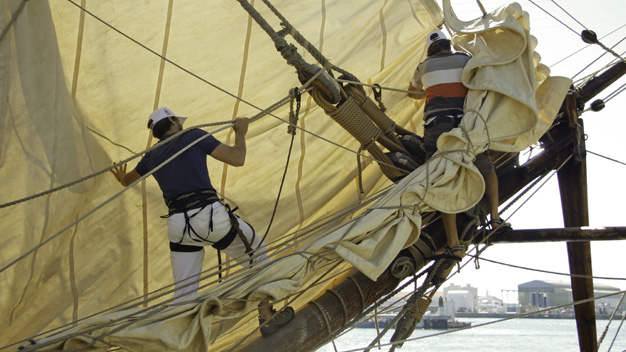First day of festival bring thousands of visitors
The first day of the official opening of activities of the Lycamobile Mediterranean Tall Ships Regatta has brought together thousands of locals who have come to Portal de la Pau, in front of the Columbus statue, which has become the race village. The boats will be moored at Barcelona’ Port Vell until 24th September and will be open to the public at various times. On the final day, at the same time as the festival of La MercíÂ, the 28 boats will parade down the city’ waterfront in the traditional Parade of Sail, before making their way to the start of the first leg of the race that will take them to the French port of Toulon.
On the quaysides there are various activities and exhibitions including “Barcelona Sails” which includes information on the Barcelona World Race, the education program for young people and the environment commitment of the race. The public can take part in the free activities, as well as finding information about the activities of the Consorci El Far – which exhibits in front of its tent two of its catboats with lateen sails or äóìmuletesäó that used to work both at sea and on rivers, Dí_nia and Mare Nostrum – and the Fundacií_ Navegacií_ Oceíænica Barcelona (FNOB). Both institutions have worked together to organize the event in Barcelona along with Sail Training International (STI).
But the stars of these festival days are the majestic Tall Ships and, especially, their crews. These boats are dedicated to teaching traditional sailing, with very rich and varied programs that have in common training values of coexistence, respect for the sea and its environment, controlled risk taking, developing self confidence and teamwork.
These are values that all the crews highlight. Rob Blair, an American who is sailing as a trainee onboard Santa Maria Manuela (Portugal), decided to get on board after learning about its program at a meeting in Amsterdam. Three years later, he is living the experience of sailing as an apprentice crew member along the Mediterranean coast. He sailed from Malaga to Barcelona and he’ now really excited to take part in the Lycamobile Mediterranean Tall Ships Regatta. During the voyage, Rob is responsible of assisting the professional crew, of whom he emphasizes their quality and friendliness: “I have always felt part of the team. It’ great to see everyone’ mutual respect and seamanship.” Coming to Barcelona was one of the motivations to be part of this adventure: “In addition to knowing the city, I hope to meet other classic boats. Who knows which I sail onboard in the future?”
Santa Eulalia, witness of several chapters of maritime history of Barcelona and the Mediterranean
One of the great attractions of visiting Port Vell is also to able to see up close and climb onboard ships that have written the history of sailing in the last two centuries. For Barcelona, the three-mast schooner Santa Eulalia (Spain) has an endearing interest. It was restored by the Barcelona Maritime Museum (MMB) and since then it has been moored at the Moll de la Fusta, part of Barcelona’ waterfront skyline. This schooner was built in 1918 to transport goods across the Mediterranean and sailed to Cuba twice. During the Civil War it was also used for the black market and was even armed with a cannon. In its more recent history, it was used for underwater works and is now a training ship operated by the MMB that aims to show classic sailing to citizens. At 95 years of age, this iconic boat is open all year to all the public who wants to visit it or sail onboard. Most of its functioning is thanks to the MMB volunteers involved in its maintenance.
First officer, Francisco Josí© Bravo, said that after the 1992 Olympic Games, Barcelona began to open up to the sea, but there is a lot of work to be done regarding traditional sailing: “There is still a long way to go, especially with classic sailing, a


